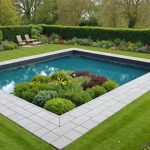Understanding Mid-Century Modern Design Principles
Mid-century modern design, celebrated for its timeless aesthetic, features clean lines, organic curves, and a harmonious balance of form and function. This design movement seeks to bridge the past with the future through uncluttered, sleek spaces. Distinctive characteristics include functional furniture, often made from woods like teak, combined with complementary metals and plastics. These materials lend warmth and adaptability to the aesthetic.
Lighting plays a crucial role in highlighting design elements. Adjustable floor lamps and pendant lights cast soft, targeted illumination that complements both the geometry and colours prevalent in mid-century modern spaces. Such lighting not only adds ambience but also accentuates design principles inherent to this style.
Sujet a lire : Creative and Functional Tips for Seamlessly Incorporating a Laundry Space into Your UK Kitchen
Integrating smart lighting with traditional mid-century elements can modernise and enhance the design’s effectiveness. Smart bulbs and fixtures can be tailored to adjust brightness and warmth, seamlessly aligning with mid-century aesthetics. This blend ensures a harmonious marriage between the era’s core design principles and today’s technological conveniences.
Incorporating technology without detracting from the essence of mid-century modern design allows enthusiasts to enjoy an aesthetic that remains both timeless and forward-thinking. Smart lighting solutions can be vital in achieving a perfect synthesis of past and present design principles.
A lire en complément : Brightening Up: Innovative Strategies to Maximize Natural Light in Your UK Basement Conversion
Benefits of Smart Lighting in Home Design
Incorporating smart lighting solutions into your home design introduces a plethora of functionality benefits. Initially, energy efficiency is a compelling driving force. Smart lighting systems often incorporate LED technology and automation, which can significantly reduce electricity consumption and, consequently, utility bills. They can also adjust their brightness based on natural lighting, minimizing unnecessary energy use.
Beyond the energy efficiency benefits, smart lighting offers unparalleled convenience. Customizable moods and settings allow users to tailor lighting to suit different times of the day or specific activities. For instance, you might prefer warm, dim lighting for a cozy evening or bright, vibrant lighting for work and study sessions. With smart lighting, these changes can be made effortlessly via an app or voice command.
Security is another vital aspect of home design where smart lighting excels. Systems can be configured to automatically switch lights on and off in various rooms while you’re away, simulating presence and thus deterring potential intruders. Moreover, certain setups can react to security system alerts by illuminating your surroundings, providing an additional layer of protection and peace of mind. Smart lighting, therefore, not only enhances the aesthetic and efficiency of spaces but also reinforces security.
Choosing the Right Smart Lighting for Mid-Century Modern Homes
Selecting smart lighting for mid-century modern homes requires consideration of both functionality and design harmony. Compatibility is crucial to ensure seamless integration with existing home systems.
Best Smart Light Bulbs for Contemporary Spaces
Smart lighting options, like smart bulbs, offer an efficient way to modernize lighting while preserving the mid-century aesthetic. Popular choices include Philips Hue, LIFX, and Sylvania Smart+, each providing versatile colours and brightness levels adaptable to contemporary spaces. When deciding, it’s essential to check the compatibility with platforms, such as Alexa or Google Assistant, to enhance your home’s smart lighting ecosystem.
Recommended Smart Lighting Fixtures
Mid-century modern homes benefit from lighting fixtures that evoke clean lines and minimalistic style. Consider Sputnik chandeliers or globe pendant lights that align with this era’s aesthetics. Brands like Ikea and West Elm offer fixtures that integrate smart technology without compromising design.
Key Features to Consider in Smart Lighting
Important features when selecting smart lighting options include dimmability, voice control, and scheduling capabilities. Energy efficiency and ease of use are vital but ensure the lighting’s compatibility with your existing home infrastructure. Remember, the right aesthetic not only improves ambiance but also enhances your home’s overall personality.
Installation Guide for Smart Lighting Solutions
Installing smart lighting might feel daunting, but with the right tools and guidance, it’s very doable. Begin by gathering essential tools: a screwdriver, pliers, a voltage tester, and, if needed, a stepladder. It’s always beneficial to check your smart bulb or fixture’s manual, as some may require additional tools.
First, ensure the power supply to the area where you are installing the smart bulb is turned off—use the voltage tester to confirm. Remove the existing bulb or fixture with the screwdriver. In case of fixtures, be mindful of any exposed wires. Install the smart bulb by simply screwing it into the socket. For fixtures, connect the wires according to colour codes: black to black, white to white, and green to ground.
Switch the power back on to test your installation. If it doesn’t work right away, double-check wire connections and ensure the bulb or fixture is seated properly. Common troubleshooting tips include:
- Checking Wi-Fi compatibility.
- Ensuring the smart hub (if needed) is properly set up.
- Consulting the step-by-step guide provided by the manufacturer.
Embrace the convenience and efficiency of DIY smart lighting as you bring your home into the future!
Transformative Smart Lighting Setups for Inspiration
Innovative lighting setups can fundamentally change the atmosphere of a home, creating spaces that are both functional and inspiring. Leveraging examples from recent smart home transformations provides insight and inspiration.
Living Room Lighting Ideas
The living room is often a focal point for smart lighting examples. Consider layering different forms of lighting to enhance both ambience and utility. Task lighting focused on reading areas can be combined with ambient lights that adjust in color temperature. This creates an inviting environment for relaxation and entertainment. Using dimming features, the atmosphere can transform with a simple command.
Bedroom Ambiance Enhancements
For the bedroom, smart lighting setups provide inspiration through subtle changes in ambiance. Soft, warm-toned lights can create a relaxing sanctuary, conducive to winding down. By adjusting the color temperature, one can mimic natural light patterns, promoting healthy sleep. Dimmable fixtures add flexibility, allowing gradual changes in brightness to suit different moods.
Kitchen Task Lighting Solutions
Task-focused smart lighting is essential for the kitchen. Customizable color temperatures ensure clarity during meal preparation, while dimming features offer gentler lighting for dining. Under-cabinet lights eliminate shadows, making tasks more efficient. Transitioning from cool white to ambient tones transforms workspaces into cozy dining environments.
UK-Based Brands and Products to Consider
Discovering the ideal UK smart lighting solution can be a rewarding journey into innovation. The UK market hosts several impressive local brands that offer cutting-edge smart lighting products with distinct features and competitive pricing.
Leading Brands in the UK
Philips Hue stands out for its extensive range of colour-changing bulbs — perfect for creating unique atmospheres. Comparatively, Hive Lighting impresses with seamless integration with other Hive smart home products, offering a cohesive smart home experience. Another notable brand is LIFX, renowned for its vibrant lighting options and energy efficiency without requiring a separate hub.
Evaluating Features and Pricing
When comparing features, Philips Hue provides robust app controls and voice command compatibility, albeit at a premium price point. In contrast, Hive Lighting offers more budget-friendly options suitable for those already invested in the Hive ecosystem. LIFX, though slightly on the higher price spectrum, takes the lead in richness of colours and ease of use.
Customer Experiences
Customer reviews frequently highlight satisfaction with the vibrant and reliable performance of Philips Hue. Hive Lighting users often appreciate their cohesive ecosystem, though occasionally express a desire for broader colour options. Meanwhile, LIFX users commend the splendid colour outputs, appreciating the hub-free setup. Each UK-based brand brings unique offerings, catering to varying preferences and needs.
Future Trends in Smart Lighting for Home Design
In the dynamic realm of smart lighting trends, new technologies continuously reshape the way we illuminate our homes. One promising direction is future technology integrating AI and home automation, crafting a more personalised and efficient lighting experience.
Upcoming technologies focus on enhancing connectivity and control. Expect innovations like smart bulbs with advanced sensors, adjusting light based on room occupancy, natural light simulation, or even mood. These adapt seamlessly, contributing to energy efficiency and user comfort.
Looking ahead, smart lighting will significantly affect design aesthetics. Picture lighting as a flexible design element rather than just functional hardware. Customisable colour palettes and intensity levels can transform spaces, aiding in setting ambience and style. Imagine a home where the lighting adapts not only in colour but in patterns, creating a symphony of light that complements the architecture.
The role of AI cannot be overstated. Future home automation leverages machine learning to predict user preferences and optimise lighting settings without manual intervention. Smart lighting systems might soon learn your daily routines, effortlessly adjusting to provide the perfect illumination at any hour. Integrating AI into lighting systems not only enhances convenience but also aligns lighting with the natural environment, promoting well-being.











